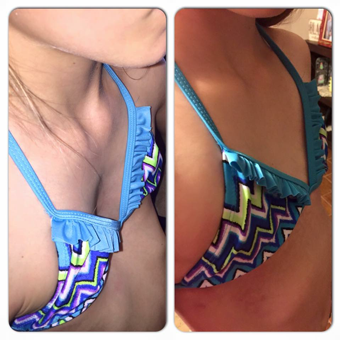For children with pectus excavatum, chest wall deformities may range from mild to severe. Mild cases might be barely noticeable. Pectus excavatum can be completely harmless, but the visual appearance can affect a child's self-image, and they may also be subjected to teasing and even bullying. Severe cases can cause a deep hollow in the chest and may affect the heart and lungs. Surgery can often correct the condition and treat any heart or lung issues.
Who gets it?
Pectus excavatum affects about 1 in 400 children, and is most common in males although females can be affected as well. Up to 40 percent of patients will have a family member, typically a parent or grandparent, who also has it, but there is no clear genetic link. There are several monogenic syndromes associated with pectus deformities including Marfan Syndrome, Homocystinuria and Ehlers-Danlos Syndrome. It can either be present at birth or not develop until puberty.
Male, before and after

Female, before and after
What causes it?
It is generally regarded as a genetic condition, based on the fact that it is usually present in several members of the same family and is often associated with other genetic diseases; however, its causes remain in debate.
What are the symptoms?
Common symptoms of chest wall deformities are:
- Sunken appearance in the chest.
- Shortness of breath.
- Decreased stamina during exercise.
In addition, your child may also have chest pain related to abnormal bone and cartilage growth. Pectus excavatum typically gets worse with age or during growth spurts that occur during adolescence.
How is it diagnosed?
Workup of pectus excavatum includes your child's medical history and a physical exam, along with one or more of the following tests:
- Chest X-ray.
- CT scan of chest.
- Cardiac ECHO.
- Pulmonary function test (PFT).
- Testing for possible nickel allergy.
- Cardiac MRI.
How is it treated?
Treatment of mild pectus excavatum may consist of exercises for improving posture and upper body strength. If your child has moderate to severe pectus excavatum, surgery may be recommended.
Nonsurgical options
For mild deformities, posture control, exercise program (e.g., deep breathing, pushups) and annual follow-up may be appropriate. Many patients are candidates for this non-operative treatment before considering surgical repair. Compliance is important for optimal results.
Surgical options
The timing of surgery is dependent on your child's age, symptoms and anatomy. Surgical options are generally deferred until mid to late adolescence–if symptoms allow–to prevent problems with chest wall compliance which may occur if done in younger patients.
Pain control and comfort
Multimodal pain control with the anesthesia pain team, and also offering intra-operative Cryo Nerve Block for 1-3 + months of post-surgical relief allowing a more rapid recovery and shorter hospitalization.
Cryo Nerve Block technology uses a unique freezing method to temporarily block pain signals from nerves in the affected area, providing an effect that’s similar to a local anesthetic.
Nuss minimally invasive repair of pectus excavatum (MIRPE)
- Uses small lateral chest incisions and a thoracoscope to place a curved stainless steel bar underneath the ribs and the sternum.
- No excision of cartilage is needed.
- The bar is removed in two to three years as an outpatient procedure.
- Most patients are candidates for this procedure, but some very asymmetric deformities may require other approaches.
Ravitch repair*
- A longer anterior thoracic incision is used to excise the abnormally shaped cartilages in a subperichondrial plane.
- An osteotomy is often made in the sternum to position it appropriately.
- A stainless-steel bar is placed to keep the sternum in position while the cartilage grows to the sternum (approximately two years).
- Some patients may be candidates for more limited resections.